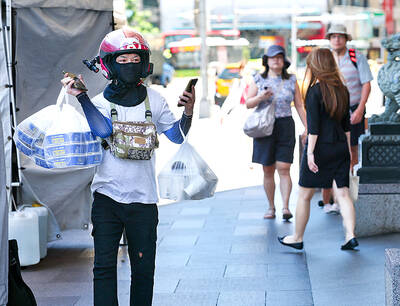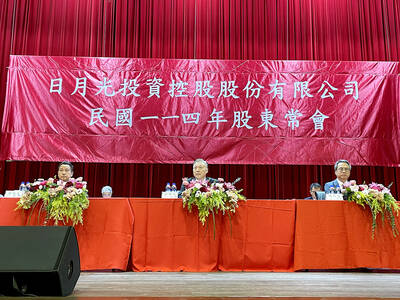The key to success for ride-hailing providers like Uber Technologies Inc is keeping drivers happy so they run their app, ensuring that enough cars respond to passenger demand.
Estonia upstart Taxify is hoping to win over drivers and take on Uber, the industry leader, by offering a larger share of the profit.
Upstarts across the world, such as Lyft Inc and Ola, are trying to catch Uber in the on-demand car-ride market by securing brand loyalty.
However, Uber has gathered critical mass and reached a valuation of more than £60 billion (US$76.9 billion) in just eight years, despite a lack of profits. It has kept rivals at bay, partly by offering incentives to drivers to stay online.
Taxify, a minnow compared to Uber, cannot afford these perks but believes that by taking a smaller share of fares — 15 to 20 percent compared with Uber’s 20 to 25 percent — it can steal market share from its San Francisco-based rival.
It also hopes that allowing drivers to take cash as well as credit card fares will also help it attract more passengers.
“Taxify’s biggest advantage is the focus on good service by treating the drivers and riders better than other platforms. This means having higher pay for drivers, thanks to lower fees,” chief executive Markus Villig said at Taxify’s headquarters in Estonia.
“By the end of the year, I think we will be No. 1 in about 10 countries in Europe and Africa,” he said.
An Uber spokeswoman declined to comment, but the company has said it had fare revenue of about US$20 billion last year.
Villig said Taxify generated fares worth “tens of millions of euros” each month.
Taxify runs in just 25 cities in Europe and Africa, while Uber operates in nearly 600 cities worldwide. Its basic business model is identical — both hook up passengers with self-employed drivers.
Many incumbent cab companies in Europe have developed apps to operate in a similar manner, but most have focused on their domestic markets.
However, Taxify is unusual in launching in about 18 countries, mainly smaller markets in Eastern Europe and Africa, where Uber is absent or not yet dominant.
Uber usually takes market share by giving drivers money to sign on to its app, paying them even if they are not driving passengers. Then, as it becomes more popular with passengers, it withdraws the inducements.
Analysts say Uber aims to build a customer franchise and stable of drivers to dominate the market.
“The way I see it, Taxify is cheaper than Uber,” said Tumelo Malatjie, 33, a former truck driver for a logistics firm turned full-time Taxify driver in Johannesburg.
“Taxify takes 15 percent and Uber about 25 percent or 30 percent,” said Malatjie, who nonetheless is on a waiting list to become an Uber driver.
Taxify has avoided expensive head-to-head battles with its much larger rival, but its model will soon be tested as Villig plans to launch in London — Uber’s biggest European market in the coming months.
Founded three-and-a-half years ago, Taxify has 140 staff worldwide, a third of whom are based in Estonia. It says it has 2.5 million active passengers in 18 countries.
Uber says it has more than 12,000 people across the world and millions of passengers in 70 countries.
In Africa, Villig said Taxify has hired away 20 former Uber executives, helping its expansion in cities like Lagos, Cairo and Johannesburg.
The start-up has raised 2 million euros (US$2.24 million) in outside financing from local venture capitalists.
Like Uber, it is losing money, although it was “close to profitability for the past six months,” Villig said.
Uber reported late last month that its net loss, excluding employee stock options and other items, narrowed in the first quarter to US$708 million, from US$991 million in the fourth quarter.
Taxify and Uber face many of the same regulatory and commercial challenges.
Uber was dealt a major setback last month to its European ambitions when the lead advocate for Europe’s highest court said it should be regulated like a transport company rather than an online electronic intermediary.
Taxify could face the same legal treatment, which would make it more susceptible to new regulations being introduced by a growing number of European cities.
Similarly, bans on ride-sharing in cities apply to Taxify as much as Uber.
Uber has faced complaints from its drivers in London, France and the US who were unhappy about compensation.
Taxify has also had protests from drivers in Estonia unhappy at how the company had slashed fare rates. Villig declined to comment.
While analysts do not expect Uber to be dethroned by Taxify anytime soon, Taxify’s lower commission model may put pressure on Uber’s margins in countries where it is seeking to cut fares or increase its share of fares.
“Uber is still the market leader, which gives them the possibility to take higher fees,” Villig said. “But I think over time, they definitely need to get more competitive.”

Merida Industry Co (美利達) has seen signs of recovery in the US and European markets this year, as customers are gradually depleting their inventories, the bicycle maker told shareholders yesterday. Given robust growth in new orders at its Taiwanese factory, coupled with its subsidiaries’ improving performance, Merida said it remains confident about the bicycle market’s prospects and expects steady growth in its core business this year. CAUTION ON CHINA However, the company must handle the Chinese market with great caution, as sales of road bikes there have declined significantly, affecting its revenue and profitability, Merida said in a statement, adding that it would

RISING: Strong exports, and life insurance companies’ efforts to manage currency risks indicates the NT dollar would eventually pass the 29 level, an expert said The New Taiwan dollar yesterday rallied to its strongest in three years amid inflows to the nation’s stock market and broad-based weakness in the US dollar. Exporter sales of the US currency and a repatriation of funds from local asset managers also played a role, said two traders, who asked not to be identified as they were not authorized to speak publicly. State-owned banks were seen buying the greenback yesterday, but only at a moderate scale, the traders said. The local currency gained 0.77 percent, outperforming almost all of its Asian peers, to close at NT$29.165 per US dollar in Taipei trading yesterday. The

RECORD LOW: Global firms’ increased inventories, tariff disputes not yet impacting Taiwan and new graduates not yet entering the market contributed to the decrease Taiwan’s unemployment rate last month dropped to 3.3 percent, the lowest for the month in 25 years, as strong exports and resilient domestic demand boosted hiring across various sectors, the Directorate-General of Budget, Accounting and Statistics (DGBAS) said yesterday. After seasonal adjustments, the jobless rate eased to 3.34 percent, the best performance in 24 years, suggesting a stable labor market, although a mild increase is expected with the graduation season from this month through August, the statistics agency said. “Potential shocks from tariff disputes between the US and China have yet to affect Taiwan’s job market,” Census Department Deputy Director Tan Wen-ling

UNCERTAINTIES: The world’s biggest chip packager and tester is closely monitoring the US’ tariff policy before making any capacity adjustments, a company official said ASE Technology Holding Inc (日月光投控), the world’s biggest chip packager and tester, yesterday said it is cautiously evaluating new advanced packaging capacity expansion in the US in response to customers’ requests amid uncertainties about the US’ tariff policy. Compared with its semiconductor peers, ASE has been relatively prudent about building new capacity in the US. However, the company is adjusting its global manufacturing footprint expansion after US President Donald Trump announced “reciprocal” tariffs in April, and new import duties targeting semiconductors and other items that are vital to national security. ASE subsidiary Siliconware Precision Industries Co (SPIL, 矽品精密) is participating in Nvidia